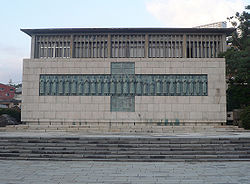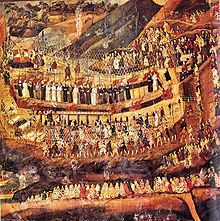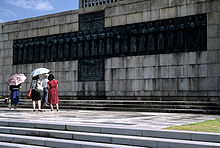- Twenty-six Martyrs of Japan
-
Martyrs of Japan 
Died February 5, 1597,Nagasaki, Japan Means of martyrdom Crucifixion Venerated in Catholic Church, Anglican Church, ELCA Beatified September 14, 1627, Rome
by Pope Urban VIIICanonized June 8, 1862, Rome
by Pope Pius IXFeast February 6 (Roman Catholic Church) The Twenty-six Martyrs of Japan (日本二十六聖人 Nihon Nijūroku Seijin) refers to a group of Christians who were executed by crucifixion on February 5, 1597 at Nagasaki. Their martyrdom is especially significant in the history of Roman Catholicism in Japan.
A promising beginning to Catholic missions in Japan — perhaps as many as 300,000 Christians by the end of the sixteenth century — met complications from competition between the missionary groups, political difficulty between Spain and Portugal, and factions within the government of Japan. Christianity was suppressed, and it was during this time that the 26 martyrs were executed. By 1630, Christianity had been driven underground. Two hundred and fifty years later, when Christian missionaries returned to Japan, they found a community of "hidden Christians" that had survived underground.
Contents
Early Christianity in Japan
Main article: KirishitanOn August 15, 1549, St. Francis Xavier (later canonized by Gregory XV in 1622), Fr. Cosme de Torres, S.J. (a Jesuit priest), and Fr. John Fernandez arrived in Kagoshima, Japan, from Spain with hopes of bringing Catholicism to Japan. On September 29, St. Francis Xavier visited Shimazu Takahisa, the daimyo of Kagoshima, asking for permission to build the first Catholic mission in Japan. The daimyo agreed in hopes of creating a trade relationship with Europe.
The shogunate and imperial government at first supported the Catholic mission and the missionaries, thinking that they would reduce the power of the Buddhist monks, and help trade with Spain and Portugal. However, the Shogunate was also wary of colonialism, seeing that in the Philippines the Spanish had taken power after converting the population. The government increasingly saw Catholicism as a threat, and started persecuting Christians. Christianity was banned and those Japanese who refused to abandon their faith were killed.
Martyrdom
 The Christian martyrs of Nagasaki. 16-17th century Japanese painting.
The Christian martyrs of Nagasaki. 16-17th century Japanese painting.
On February 5, 1597, twenty-six Christians – six European Franciscan missionaries, three Japanese Jesuits and seventeen Japanese laymen including three young boys, who were all members of the Third Order of St. Francis – were executed by crucifixion in Nagasaki on the orders of Hideyoshi Toyotomi.[1] These individuals were raised on crosses and then pierced through with spears.
Persecution continued sporadically, breaking out again in 1613 and 1630. On September 10, 1632, 55 Christians were martyred in Nagasaki in what became known as the Great Genna Martyrdom. At this time Catholicism was officially outlawed. The Church remained without clergy and theological teaching disintegrated until the arrival of Western missionaries in the nineteenth century.
While there were many more martyrs, the first martyrs came to be especially revered, the most celebrated of which was Paul Miki. The Martyrs of Japan were canonized by the Roman Catholic Church on June 8, 1862 by Blessed Pius IX,[2] and are listed on the calendar as Sts. Paul Miki and his Companions, commemorated on February 6, February 5, the date of their death, being the feast of Saint Agatha. They were included in the General Roman Calendar for the first time in 1969; accordingly those who observe the universal versions of earlier calendars, such as the General Roman Calendar of 1962, the General Roman Calendar of Pope Pius XII, the General Roman Calendar as in 1954 and, of course, the Tridentine Calendar, in which these saints do not appear, give them no liturgical veneration. They are, however, provided with their own Mass texts (Collect, Secret and Postcommunion) under February 13 - the first Feria after the date of their martyrdom - in the pro aliquibus locis section of missals used by those observing the General Roman Calendar of 1962.[3] [4]
Drawn from the oral histories of Japanese Catholic communities, Shusaku Endo's acclaimed novel Silence provides detailed accounts of the persecution of Christian communities and the suppression of the Church.
Recognition
Further information: Twenty-Six Martyrs Museum and MonumentThe first martyrs of Japan are commemorated on February 5 when, on that date in 1597, twenty-six missionaries and converts were killed by crucifixion. Nippon Sei Ko Kai, a member of the Anglican Communion, added the martyrs to their calendar in 1959 to commemorate all the martyrs of Japan. The Episcopal Church and the Evangelical Lutheran Church in America added the commemoration to their calendars during the revision of their respective prayer books in late 1970s. Some parts of the Anglican Communion and the ELCA commemorate the martyrs of Japan on February 5, while the Catholic Church and the Church of England commemorate them on February 6.
The Church of the Holy Japanese Martyrs (Civitavecchia, Italy) is a Catholic church that is dedicated to the 26 Martyrs of Nagasaki. It is decorated with the artwork of Japanese artist Luke Hasegawa.
List of the 26 Martyrs of 1597
 Statue of Philip of Jesus in the Basilica of Our Lady of Zapopan.
Statue of Philip of Jesus in the Basilica of Our Lady of Zapopan.
- Saint Antonio Dainan
- Saint Bonaventura of Miyako
- Saint Cosme Takeya
- Saint Francisco Branco
- Saint Francisco of Nagasaki
- Saint Francisco of Saint Michael
- Saint Gabriel de Duisco
- Saint Gaius Francis
- Saint Gundisalvus (Gonsalvo) Garcia
- Saint Isabel Fernandez
- Saint Ignatius Jorjes
- Saint James Kisai
- Saint Joaquim Saccachibara
- Saint Juan Kisaka
- Saint Juan Soan de Goto
- Saint Leo Karasumaru
- Saint Luis Ibaraki
- Saint Martin of the Ascension
- Saint Mathias of Miyako
- Saint Miguel Kozaki
- Saint Paulo Ibaraki
- Saint Paul Miki or Saint Paulo Miki – Born in Japan in 1562, he joined the Society of Jesus in 1580 and was the first Japanese member of any Catholic religious order. He died one year before his ordination to the Catholic priesthood. Miki's remaining ashes and bones are now located in Macau, China.
- Saint Pablo Suzuki
- Saint Pedro Bautista or Saint Peter Baptist – He was a Spanish Franciscan who had worked about ten years in the Philippines before coming to Japan. St. Peter was a companion of St. Paul Miki when Christianity was made illegal.[5]
- Saint Pedro Sukejiroo
- Saint Philip of Jesus - Born in Mexico in 1572 (at the time "New Spain"). Upon his martyrdom he became the first Mexican saint and patron saint of Mexico City.
- Saint Thomas Kozaki
- Saint Thomas Xico
See also
- Christianity in Japan
- Kirishitan
- Martyrs of Japan
- Nanban trade
- Roman Catholicism in Japan
- Twenty-Six Martyrs Museum and Monument
Notes
- ^ "Martyrs List". Twenty-Six Martyrs Museum. http://www1.bbiq.jp/martyrs/ListEngl.html. Retrieved 2010-01-10.
- ^ Catholic Encyclopedia: Sts. Peter Baptist and Twenty-Five Companions
- ^ The Daily Missal and Liturgical Manual. London: Baronius Press. 2008. pp. 1722–1723. ISBN 978-0-9545631-2-7.
- ^ The Roman Catholic Daily Missal. Kansas City, Missouri: Angelus Press. 2004. pp. 1637–1638. ISBN 1-892331-29-2.
- ^
 "Sts. Peter Baptist and Twenty-Five Companions". Catholic Encyclopedia. New York: Robert Appleton Company. 1913.
"Sts. Peter Baptist and Twenty-Five Companions". Catholic Encyclopedia. New York: Robert Appleton Company. 1913.
External links
- The 26 Martyrs Museum in Nagasaki City, Japan
- Catholic Bishops Conference of Japan: Timeline of the Catholic Church in Japan
- Daughters of St. Paul Convent, Tokyo, Japan: Prohibition of Christian religion by Hideyoshi and the 26 martyrs
- St.Joseph's Church, Nishijin, Kyoto, Japan: The first Roman Catholic Church on the 26 Martyrs' pilgrimage to Nagasaki
- "Japanese Martyrs". Catholic Encyclopedia. New York: Robert Appleton Company. 1913. http://www.newadvent.org/cathen/09744a.htm.
- The Japanese Martyrs
- Augustinian Martyrs of Japan
- Nagasaki Wiki: Detailed Access Information from Nagasaki Station to 26 Martyrs Monument
Categories:- 1597 deaths
- 1597 in Japan
- 16th-century Christian saints
- 16th-century executions by Japan
- 16th-century Roman Catholic martyrs
- Anglican saints
- Articles about multiple people
- Child saints
- Christianity in Japan
- Executed children
- Executed Japanese people
- Feudal Japan
- History of Japan
- Japanese Roman Catholic saints
- Japanese saints
- Lists of martyrs
- People executed by crucifixion
- Pope Pius IX
- Roman Catholic Church in Japan
- Jesuit Asia missions
- Jesuit martyrs
- Franciscan martyrs
- Third Order of Saint Francis
Wikimedia Foundation. 2010.

